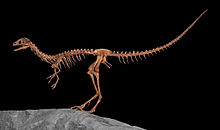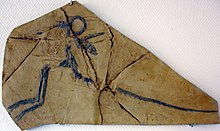美颌龙属
| 美颌龙属 化石时期:
| |
|---|---|

| |
| 美颌龙的骨架模型,位于北美洲古生物博物馆 | |
| 科学分类 | |
| 界: | 动物界 Animalia |
| 门: | 脊索动物门 Chordata |
| 纲: | 蜥形纲 Sauropsida |
| 总目: | 恐龙总目 Dinosauria |
| 目: | 蜥臀目 Saurischia |
| 亚目: | 兽脚亚目 Theropoda |
| 科: | †美颌龙科 Compsognathidae |
| 亚科: | †美颌龙亚科 Compsognathinae |
| 属: | †美颌龙属 Compsognathus Wagner, 1859 |
| 模式种 | |
| 长足美颌龙 Compsognathus longipes Wagner, 1859
| |
美颌龙属(属名:Compsognathus)又称细颚龙、美颚龙、细颈龙、新颚龙、秀颚龙,是一属小型的双足肉食性兽脚亚目恐龙。它约有火鸡的大小,生存于欧洲。古生物学家已发现两个保存良好的化石,一个于1850年代在德国发现,另一个是在将近一个世纪后于法国发现。美颌龙是几类确知其食性的恐龙之一,在两个标本的体内都有小型的蜥蜴化石。在葡萄牙发现的牙齿有可能也属于美颌龙。它的名字是来自古希腊文的“κομψος”(意即美丽)及“γναθος”(意即颚或颌)[1]。
美颌龙的两个化石都是较为完整的骨骼。目前的已承认种只有长足美颌龙(C. longipes)。不过,在1970年代于法国发现的较大标本,曾被认为是另一个种,而被命名为C. corallestris。德国标本目前被发现是个幼年个体,两个标本属于相同物种。直到1990年代在亚洲发现许多更小型的恐龙以前,美颌龙曾被认为是最小型的非鸟型恐龙,也一度被认为是始祖鸟的近亲。因此在古生物学界之外,美颌龙也是广为大众所熟悉的恐龙之一。
描述[编辑]

几十年来,美颌龙都被描述为最小型的恐龙。第一个发现的美颌龙标本只有约1公尺长,拥有小下颚和长脚。但是之后发现的小型恐龙,如亚洲近颌龙、小盗龙及小驰龙的体型更小型。根据最大型的标本,美颌龙的体重被估计重约0.83到3.5公斤[2][3]。
美颌龙是一小型、双足的动物,有著长的后肢及尾巴,长尾巴可在移动时平衡身体。前肢比后肢小,手掌有三指,都有著利爪,用来抓捕猎物。头颅骨细致、窄长,鼻端呈锥形。头颅骨有五对洞孔,最大的是其眼窝[4]。眼睛相对于头颅骨的比例很大。
下颌修长,但没有下颌孔(Mandibular fenestrae),这是主龙类的常见特征。牙齿小而锋利,适合吃小型的脊椎动物及其他动物,如昆虫。除了在前上颌骨的前段牙齿外,其他的牙齿都有著锯齿边缘、大幅弯曲[5]。科学家们就是用这个特征来辨别美颌龙及它的近亲[6]。
发现及物种[编辑]

目前已发现的美颌龙标本是两个接近完整的身体骨骼,一个标本是从德国发现,长约89公分,另一个标本则是从法国发现,长约125公分[7]。德国标本(编号BSP AS I 563)是在1859年出土于巴伐利亚的索侯芬石灰岩层[8]。索侯芬石灰岩层属于提通阶早期,曾发现了一些保存状态完好的化石,例如有羽毛印痕的始祖鸟标本,一些翼龙目化石也有翼膜印痕。这个德国标本很可能来自于派恩滕组(Painten Formation),地质年代为启莫里阶最上层,约1亿5080万年前[9]。其他的可能挖掘地点是Jachenhausen[10]或高德堡(Goldberg),这两地的地质年代都为提通阶[9]。在1859年,约翰·安德列亚斯·瓦格纳(Johann A. Wagner)概略的描述这个标本,并命名为长足美颌龙(Compsognathus longipes)[11]。之后在1861年才进行详细的描述[12]。接下来几年,德国解剖学家卡尔·根格包尔(Karl Gegenbaur)、美国古动物学家爱德华·德林克·科普曾提出美颌龙、始祖鸟有类似处[13][14]。 在1868年初,汤玛斯·亨利·赫胥黎参考前述假设,比较美颌龙、始祖鸟的标本,赫胥黎发现两者的差异只有手臂比例、有无羽毛,而推论美颌龙与始祖鸟是近亲,而原始鸟类也与恐龙有亲缘关系[15][16]。而在1896年,奥塞内尔·查利斯·马什确认这些美颌龙化石属于恐龙[17]。在1978年,约翰·奥斯特伦姆(John Ostrom)详细的重新描述这个物种,令美颌龙成为当时最知名的小型兽脚亚目[18]。德国标本目前在德国慕尼黑的巴伐利亚国家古生物和地质收藏馆中展览。

较大的法国标本(编号MNHN CNJ 79)是在1971年被发现于法国东南部尼斯附近的一个采石场,属于波特兰石灰岩层。该地层的地质年代为提通阶早期。虽然它原先被命名为第二个种,C. corallestris[19],但于1991年被归类为长足美颌龙的另一个标本[20][21]。小型的德国标本被认为是长足美颌龙的幼年个体[22]。在1983年,巴黎的国立自然历史博物馆得到了这个法国标本[20]。
之后,化石收集者Heinrich Fischer在索侯芬石灰岩层发现的部份脚掌,曾被认为是属于长足美颌龙。后来的研究推翻了这个主张[23],包含约翰·奥斯特伦姆在内。德国古生物学家弗雷德里克·冯·休尼(Friedrich von Huene)则维持新标本属于美颌龙的意见[24]。此外在1998年,Jens Zinke将发现于葡萄牙的49颗牙齿化石编入此属,地质年代为启莫里阶。由于牙齿的锯齿状边缘,这些牙齿化石不是列入长足美颌龙,而是列为美颌龙属的未命名种(Compsognathus sp.)[25]。
在1997年,Virginia Morell将中华龙鸟列为美颌龙的一个种,成为原始美颌龙(Compsognathus prima)[26]但并没有被普遍接纳。

古生态学[编辑]
在侏罗纪晚期,欧洲是一片干旱及热带的群岛,位于特提斯洋的边缘。发现美颌龙的石灰岩层,源自于海洋生物的壳所生成的方解石。两个发现美颌龙的地点都是座落于海滩与珊瑚礁之间的礁湖[27]。与美颌龙生存于同时代与相同地区的动物,包括始祖鸟、喙嘴龙及翼手龙。发现美颌龙的地层,也发现一些海洋动物的化石,如鱼类、介虫、棘皮动物及海洋软体动物,确定它是栖息在海岸环境。这些地层没有发现美颌龙以外的其他恐龙,可见这小型的恐龙是这些岛上的顶级捕猎动物。
古生物学[编辑]

前肢[编辑]
在19世纪发现的美颌龙德国标本,前肢只有二指,使科学家们以为它们就是这样[18]。但是,后来发现的法国标本显示美颌龙的前肢是有三指的[28],类似其他美颌龙科。德国标本的手掌没有在化石化过程中保存下来,更有研究认为法国标本的手掌是有蹼的[19]。在1975年出版的书籍《The Evolution and Ecology of the Dinosaurs》,美颌龙被描绘成为两栖的恐龙,能够捕猎水中的猎物,及逃离巨大的捕猎动物[29]。但是,奥斯特伦姆却证实了法国标本与德国标本除了体型外,几乎是完全一样的,继而推翻了这个假说[18][21]。
食性[编辑]
德国标本胸腔内的蜥蜴化石,显示美颌龙会捕猎小型的脊椎动物[6]。在1881年,马什研究了这个标本,并认为在美颌龙肚内的小型骨骼是胚胎。但在1903年,法兰兹·诺普乔(Franz Nopcsa)研判这是一头蜥蜴[30]。奥斯特伦姆发现这些化石是属于巴伐利亚蜥(Bavarisaurus)[31],并从它尾巴与四肢的长比例,认定它能快速及灵活地奔跑。从这可推论美颌龙有著锐利视力,并能够迅速的追上这种灵活的蜥蜴[18]。美颌龙肚中的巴伐利亚蜥是完整的,可见它是完整地吞下猎物。法国标本的胃部也有归类不明的蜥蜴或喙头蜥目[21]。
蛋化石[编辑]
在德国标本的附近发现了一些直径约10公分的蛋。在1901年,德国古生物学家弗雷德里克·冯·休尼解释这是骨化真皮[32]。1993年的一个重新研究中,指出它们其实是未发展成熟的蛋[33]。但是,后来的研究怀疑这些蛋是否属于美颌龙属,因为它们都是在体腔之外被发现。一个保存完好的中华龙鸟化石,在两条输卵管中有两颗未生的蛋。由于中华龙鸟的蛋数量少,与标本的比例较大,使科学家更质疑这些蛋是否属于美颌龙属[6]。在1964年,德国地质学家Karl Werner Barthel提出这个圆形物是尸体腐化时产生的气泡[34]。
羽毛及与鸟类的关系[编辑]

有将近一个世纪的时间,美颌龙是唯一广为人知的小型兽脚亚目恐龙。这令人将它与始祖鸟产生比较,及产生美颌龙与鸟类之关系的讨论。事实上,美颌龙使赫胥黎激起对鸟类起源的兴趣,远大于始祖鸟对他的影响[35]。这两种动物在体型、大小及比例上都有著相似性,所以两个没有羽毛的始祖鸟化石经常被误会为美颌龙[4]。很多其他的恐龙,包括恐爪龙、偷蛋龙及慢龙都曾被认为是鸟类的近亲。
美颌龙的化石没有保存羽毛、或类似羽毛的痕迹;相反地,同样发现于德国地层的始祖鸟却有羽毛痕迹。所以很多早期科学家都认为美颌龙是没有羽毛的。但是,已知唯一的始祖鸟羽毛,是位在翅膀及尾巴上的较大羽毛,而被推测覆盖身体的较短羽毛却没有被保存下来。冯·休尼指出德国美颌龙标本的下腹保存了化石化的皮肤[32],但奥斯特伦姆后来推翻这个论点[18]。在2012年,Achim Reisdorf提出美颌龙下腹的皮肤痕迹,其实是尸蜡[9]。在2006年,Karin Peyer宣称在法国美颌龙标本的第13节尾椎处,发现鳞片皮肤痕迹,由小型瘤块鳞片构成,类似侏罗猎龙的后肢、尾巴鳞片[36]。
美颌龙的近亲(如中华龙鸟、中华丽羽龙)的化石都覆盖者构造简易的绒羽[37],显示美颌龙也可能有类似的原始绒羽[38]。同属于美颌龙科的侏罗猎龙,它化石化的尾巴及后肢皮肤有鳞片皮肤,而近年在化石周围发现疑似原始羽毛的可疑痕迹[39]。所以美颌龙可能大部分身体覆盖者鳞片,而其馀小部分则覆盖者羽毛,不过侏罗猎龙是否属于美颌龙科也遭到质疑[40][41]。
病征[编辑]
在2001年,布鲁斯·罗斯柴尔德(Bruce Rothschild)等人发表一份兽脚类恐龙的压力性骨折研究。他们研究9个美颌龙的脚掌骨骼,没有发现压力性骨折的迹象[42]。
分类[编辑]

美颌龙科的名称来自于美颌龙,这科目前包含大部份生存于晚侏罗纪至下白垩纪在中国、欧洲及南美洲的小型恐龙[21]。许多年来,美颌龙是该科的唯一属,直至近年古生物学家发现了几个近亲属。该演化支包括极鳄龙[43]、华夏颌龙[44]、小坐骨龙[45]、中华龙鸟[37][46],可能还有侏罗猎龙[47]及棒爪龙[48]。单爪龙曾一度被归类于此科,但这已在1998年被否定了,而单爪龙与美颌龙科的相似性是趋同演化的后果[6]。美颌龙及其近亲在虚骨龙类中的演化位置不明。在2004年,兽脚类专家托马斯・霍兹(Thomas Holtz Jr )、拉弗·莫纳儿(Ralph Molnar)、菲力·柯尔(Phil Currie)等人认为美颌龙科是最原始的虚骨龙类[49],而其他科学家认为该科是属于手盗龙类[50][51]。
大众文化[编辑]
美颌龙经常出现在儿童读物中。长期以来,美颌龙因为它们的体型小而著名;而在至少一个世纪之后,才发现、命名大部分的其他小型恐龙[52][53]。
美颌龙曾出现在电影《侏㑩纪公园:失落的世界》(The Lost World: Jurassic Park)、《侏㑩纪公园III》(Jurassic Park III)以及《侏㑩纪世界:陨落国度》中。在《侏㑩纪公园:失落的世界》中,美颌龙被误名为三叠美颌龙(Compsognathus triassicus),结合美颌龙的属名以及原美颌龙的种名;原美颌龙是美颌龙的三叠纪远亲,出现在《侏㑩纪公园》的原著小说[54]。美颌龙通常在英文中被昵称为“Compys”。它们通常被叙述成小群体动物,这行为来自于《侏㑩纪公园》的原著小说。但没有科学证据显示美颌龙与原美颌龙有这种社会行为。
参考资料[编辑]
- ^ (英文)Liddell & Scott. Greek-English Lexicon, Abridged Edition. Oxford University Press, Oxford, UK. 1980. ISBN 978-0-19-910207-5.
- ^ (英文)Therrien, F.; Henderson, D.M. My theropod is bigger than yours...or not: estimating body size from skull length in theropods. Journal of Vertebrate Paleontology. 2007, 27 (1): 108–115. doi:10.1671/0272-4634(2007)27[108:MTIBTY]2.0.CO;2.
- ^ (英文)Seebacher, F. A new method to calculate allometric length-mass relationships of dinosaurs. Journal of Vertebrate Paleontology. 2001, 21 (1): 51–60. doi:10.1671/0272-4634(2001)021[0051:ANMTCA]2.0.CO;2.
- ^ 4.0 4.1 (英文)Lambert, David. The Ultimate Dinosaur Book. New York: Dorling Kindersley. 1993: 38–81. ISBN 978-1-56458-304-8.
- ^ (德文)Stromer, E., 1934, "Die Zähne des Compsognathus und Bemerkungen über das Gebiss der Theropoda", Zentralblatt für Mineralalogie, Geologie und Paläontologie, Abteilung B, Jahrgang 1934: 74–85
- ^ 6.0 6.1 6.2 6.3 (英文)Chen, Pei-ji; Zhi-ming Dong and Shuo-nan Zhen. An exceptionally well-preserved theropod dinosaur from the Yixian Formation of China. Nature. 1998, 391: 147–152 [2007-06-07]. Bibcode:1998Natur.391..147C. doi:10.1038/34356. (原始内容存档于2007-05-15).
- ^ (英文)Paul, Gregory S. Early Avetheropods. Predatory Dinosaurs of the World. New York: Simon & Schuster. 1988: 297–300. ISBN 0-671-61946-2.
- ^ (德文)Wellnhofer, P. Dinosaurier. Archaeopteryx — der Urvogel von Solnhofen. Munich: Verlag Dr. Friedrich Pfeil. 2008: 256. ISBN 978-3-89937-076-8.
- ^ 9.0 9.1 9.2 (德文)Reisdorf, A.G., and Wuttke, M. (2012). "Re-evaluating Moodie's Opisthotonic-Posture Hypothesis in fossil vertebrates. Part I: Reptiles - The taphonomy of the bipedal dinosaurs Compsognathus longipes and Juravenator starki from the Solnhofen Archipelago (Jurassic, Germany)." Palaeobiodiversity and Palaeoenvironments, 92(1): 119-168 doi:10.1007/s12549-011-0068-y
- ^ (德文)Mäuser M. 1983, "Neue Gedanken über Compsognathus longipes WAGNER und dessen Fundort", In: Erwin Rutte-Festschrift, Weitenburger Akademie, pp 157–162
- ^ (德文)Wagner, J. A. Über einige im lithographischen Schiefer neu aufgefundene Schildkröten und Saurier. Gelehrte Anzeigen der Bayerischen Akademie der Wissenschaften. 1859, 49: 553.
- ^ (德文)Wagner, A. Neue Beiträge zur Kenntnis der urweltlichen Fauna des lithographischen Schiefers; V. Compsognathus longipes Wagner.. Abhandlungen der Bayerischen Akademie der Wissenschaften. 1861, 9: 30–38.
- ^ (德文)Gegenbaur, C. Vergleichend-anatomische Bemerkungen über das Fußskelet der Vögel. Archiv für Anatomie, Physiologie und Wissenschaftliche Medicin. 1863, 1863: 450–472.
- ^ (英文)Cope, E.D. An account of the extinct reptiles which approached the birds. Proceedings of the Academy of Natural Sciences of Philadelphia. 1867, 19: 234–235.
- ^ (英文)Huxley, T.H. On the animals which are most nearly intermediate between birds and reptiles. Annals and Magazine of Natural History, London. 1868, 2: 66–75.
- ^ (英文)Foster, Michael; Lankester, E. Ray 1898–1903. The scientific memoirs of Thomas Henry Huxley. 4 vols and supplement, London: Macmillan.
- ^ (英文)Marsh, O.C. Classification of dinosaurs. Geological Magazine. 1896, 3: 388–400.
- ^ 18.0 18.1 18.2 18.3 18.4 (英文)Ostrom, J.H. The osteology of Compsognathus longipes.. Zitteliana. 1978, 4: 73–118.
- ^ 19.0 19.1 (法文)Bidar, A.; Demay L., Thomel G. Compsognathus corallestris, une nouvelle espèce de dinosaurien théropode du Portlandien de Canjuers (Sud-Est de la France).. Annales du Muséum d’Histoire Naturelle de Nice. 1972, 1: 9–40.
- ^ 20.0 20.1 (法文)Michard, J. G. Description du Compsognathus (Saurischia, Theropoda) de Canjuers (Jurassique supérieur du Sud-est de la France), position phylogénétique, relation avec Archaeopteryx et implications sur l’origine théropodienne des oiseaux,. Ph.D. dissertation, Muséum National d’Histoire Naturelle, Paris. 1991.
- ^ 21.0 21.1 21.2 21.3 (英文)Peyer, K. A Reconsideration Of Compsognathus From The Upper Tithonian Of Canjuers, Southeastern France.. Journal of Vertebrate Paleontology. 2006, 26 (4): 879–896. doi:10.1671/0272-4634(2006)26[879:AROCFT]2.0.CO;2.
- ^ (英文)Callison, G.; H. M. Quimby. Tiny dinosaurs: Are they fully grown?. Journal of Vertebrate Paleontology. 1984, 3 (4): 200–209. doi:10.1080/02724634.1984.10011975.
- ^ (德文)Dames, W.B., 1884, "Vorlegung der Metatarsen eines Compsognathus-ähnlichen Reptils von Solenhofen", Sitzungsberichte der Gesellschaft Naturforschender Freunde zu Berlin, Jahrgang 1884, pp. 179-180
- ^ (德文)Huene, F.R., von, 1925, "Eine neue Rekonstruktion von Compsognathus longipes", Zentralblatt für Mineralogie, Geologie und Palaeontologie Jahrgang 1925, Abteilung B(5): 157-160
- ^ (英文)Zinke, J. Small theropod teeth from the Upper Jurassic coal mine of Guimarota (Portugal).. Palaontologische Zeitschrift. 1998, 72: 179–189. (原始内容存档于2007-09-27).
- ^ (英文)Morell, V. The origin of birds: the dinosaur debate. Audubon Magazine. 1997, 99 (2): 36–45.
- ^ (英文)Viohl, G. Geology of the Solnhofen lithographic limestone and the habitat of Archaeopteryx. Hecht MK, Ostrom JH, Viohl G, Wellnhofer P, (eds.) (编). The Beginnings of Birds: Proceedings of the International Archaeopteryx Conference.. Eichstätt: Freunde des Jura-Museums. 1985: 31–44.
- ^ (英文)Gauthier, J.; Gishlick A.D. Re-examination of the manus of Compsognathus and its relevance to the original morphology of the Coelurosaur manus.. Journal of Vertebrate Paleontology. 2000, 20 (3, Supplement): 43A.
- ^ Halstead L.B. The evolution and ecology of the dinosaurs. Eurobook. 1975. ISBN 978-0-85654-018-9.
- ^ (德文)Nopsca, Baron F. Neues ueber Compsognathus. Neues Jahrbuch fur Mineralogie, Geologie und Palaeontologie (Stuttgart). 1903, 16: 476–494.
- ^ (德文)Evans, S.E. The Solnhofen (Jurassic: Tithonian) lizard genus Bavarisaurus: new skull material and a reinterpretation. Neues Jahrbuch für Paläontologie und Geologie, Abhandlungen. 1994, 192: 37–52.
- ^ 32.0 32.1 (德文)von Huene, F. Der vermuthliche Hautpanzer des "Compsognathus longipes" Wagner. Neues Jahrbuch für Mineralogie, Geologie and Palaeontologie. 1901, 1: 157–160.
- ^ (英文)Griffiths, P. The question of Compsognathus eggs. Revue de Paleobiologie Spec. 1993, 7: 85–94.
- ^ (德文)Barthel, K.W. Zur Entstehung der Solnhofener Plattenkalke (unteres Untertithon). Mitteilungen der Bayerischen Staatssammlung für Paläontologie und historische Geologie. 1964, 4: 7–69.
- ^ (英文)Fastovsky DE, Weishampel DB. Theropoda I:Nature red in tooth and claw. Fastovsky DE, Weishampel DB (编). The Evolution and Extinction of the Dinosaurs (2nd Edition). Cambridge University Press. 2005: 265–299. ISBN 978-0-521-81172-9.
- ^ (英文)Peyer, K. A reconsideration of Compsognathus from the Upper Tithonian of Canjuers, southeastern France. Journal of Vertebrate Paleontology. 2006, 26 (4): 879–896. doi:10.1671/0272-4634(2006)26[879:AROCFT]2.0.CO;2.
- ^ 37.0 37.1 (英文)Currie, P.J.; P. Chen. Anatomy of Sinosauropteryx prima from Liaoning, northeastern China. Canadian Journal of Earth Sciences. 2001, 38 (12): 1705–1727. doi:10.1139/cjes-38-12-1705.
- ^ (英文)Ji, S.; Ji, Q.; Lu, J.; Yuan, C. A new giant compsognathid dinosaur with long filamentous integuments from Lower Cretaceous of Northeastern China. Acta Geologica Sinica. 2007, 81 (1): 8–15.
- ^ (德文)Goehlich, U.B.; Tischlinger, H.; Chiappe, L.M. Juraventaor starki (Reptilia, Theropoda) ein nuer Raubdinosaurier aus dem Oberjura der Suedlichen Frankenalb (Sueddeutschland): Skelettanatomie und Wiechteilbefunde. Archaeopteryx. 2006, 24: 1–26.
- ^ (英文)Xu, Xing. Palaeontology: Scales, feathers and dinosaurs. Nature. 2006, 440 (7082): 287. Bibcode:2006Natur.440..287X. PMID 16541058. doi:10.1038/440287a.
- ^ (英文)Butler, R.J., and Upchurch, P. (2007). "Highly incomplete taxa and the phylogenetic relationships of the theropod dinosaur Juravenator starki." Journal of Vertebrate Paleontology, 27(1): 253–256.
- ^ Rothschild, B., Tanke, D. H., and Ford, T. L., 2001, Theropod stress fractures and tendon avulsions as a clue to activity: In: Mesozoic Vertebrate Life, edited by Tanke, D. H., and Carpenter, K., Indiana University Press, p. 331-336.
- ^ (英文)Seeley, H.G. On Aristosuchus pusillus (Owen), being further notes on the fossils described by Sir. R. Owen as Poikilopleuron pusillus, Owen. Quarterly Journal of the Geological Society of London. 1887, 43: 221–228.
- ^ (英文)Hwang, S.H.; M. A. Norell, J. Qiang and G. Keqin. A large compsognathid from the Early Cretaceous Yixian Formation of China. Journal of Systematic Paleontology. 2004, 2: 13–39. doi:10.1017/S1477201903001081.
- ^ (英文)Naish, D.; Martill, D. M. and Frey, E. Ecology, systematics and biogeographical relationships of dinosaurs, including a new theropod, from the Santana Formation (?Albian, Early Cretaceous) of Brazil. Historical Biology. 2004: 1–14.
- ^ Ji, Q.; Ji S.A. On discovery of the earliest bird fossil in China and the origin of birds (in chinese). Chinese Geology. 1996, 233: 30–33.
- ^ (英文)Göhlich, U.; L. M Chiappe. A new carnivorous dinosaur from the Late Jurassic Solnhofen archipelago. Nature. 2006, 440 (7082): 329–332. doi:10.1038/nature04579.
- ^ (英文)Dal Sasso, C.; M. Signore. Exceptional soft-tissue preservation in a theropod dinosaur from Italy. Nature. 1998, 392 (6674): 383–387. doi:10.1038/32884.
- ^ (英文)Holtz TR, Molnar RE, Currie PJ. Basal Tetanurae. Weishampel DB, Osmólska H, Dodson P (编). The Dinosauria (2nd Edition). University of California Press. 2004: 105. ISBN 978-0-520-24209-8.
- ^ (英文)Gauthier, J.A. Saurischian monophyly and the origin of birds. In Padian, K. (ed.) The Origin of Birds and the Evolution of Flight, Memoirs of the California Academy of Sciences. 1986, 8: 1–55.
- ^ (英文)Forster, C.A.; Sampson, S.D., Chiappe, L.M. & Krause, D.W. The theropod ancestry of birds: new evidence from the Late Cretaceous of Madagascar.. Science. 1998, 279: 1915–1919. doi:10.1126/science.279.5358.1915.
- ^ (英文)Wilson, Ron. 100 Dinosaurs from A to Z. New York: Grosset & Dunlap. 1986: 18. ISBN 0-448-18992-5.
- ^ (英文)Attmore, Stephen. Dinosaurs. Newmarket, England: Brimax Books. 1988: 18. ISBN 0-86112-460-X.
- ^ (英文)Berry, Mark F. The dinosaur filmography. Jefferson, North Carolina: McFarland. 2002: 273. ISBN 0-7864-1028-0.
外部链接[编辑]
| 维基物种上的相关信息:美颌龙 |
| 维基共享资源中相关的多媒体资源:美颌龙 |
|















